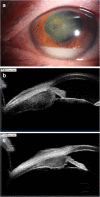Bilateral mantle cell lymphoma of the ciliary body that responded to a combined local radiotherapy and chemotherapy regimen: a case report
- PMID: 30987612
- PMCID: PMC6466781
- DOI: 10.1186/s12885-019-5530-7
Bilateral mantle cell lymphoma of the ciliary body that responded to a combined local radiotherapy and chemotherapy regimen: a case report
Abstract
Background: Mantle cell lymphoma (MCL) is a rare, aggressive B-cell non-Hodgkin lymphoma (NHL) that often affects men over the age of 60. Systemic metastasis of MCL to eyes is rare and intraocular involvement is even rarer, which usually affects the choroid and iris. To the best of our knowledge, ciliary body metastasis of systemic MCL has not been reported.
Case presentation: A 59-year-old Han Chinese male with past-history of systemic MCL complained of redness, pain and blurred vision in the left eye. Ocular examination revealed a normal appearance in the right eye, and conjunctival injection, pseudohypopyon and anterior protrusion of peripheral iris in the left eye, all of which were unresponsive to corticosteroid treatments. Ultrasound biomicroscopy (UBM) and B-scan were then performed which detected ciliary body masses in both eyes with no vitreous and retino-choroidal anomalies. Combined liquid-based cytology tests and gene rearrangement assays of the aqueous humor specimen confirmed this to be a B-cell malignancy. Then both eyes were treated with external beam irradiation (40 Gy, delivered evenly in twenty fractions) over a course of one month. Additionally, the left eye received intravitreal methotrexate (MTX) (weekly for the first month, every two weeks for the second month, and monthly thereafter) over a course of twelve months. This therapy eventually led to complete remission of all symptoms in one month and disappearance of the ciliary body masses in twelve months.
Conclusion: Here we first reported a case of bilateral ciliary body MCL infiltration which was diagnosed by combined liguid-based cytology and gene rearrangement of aqueous humor cells. UBM may serve as a valuable tool in the diagnosis and serial assessments of anterior segment tumors.
Keywords: Ciliary body; Mantle cell lymphoma; Non-Hodgkin lymphoma; Ultrasound biomicroscopy.
Conflict of interest statement
Ethics approval and consent to participate
Not applicable.
Consent for publication
Written informed consent for publication of their clinical details and clinical images was obtained from his wife of the patient. A copy of the written consent is available by the editor of the journal.
Competing interests
The authors declare that they have no competing interests.
Publisher’s Note
Springer Nature remains neutral with regard to jurisdictional claims in published maps and institutional affiliations.
Figures



References
-
- Dreyling M, Jurczak W, Jerkeman M, Silva RS, Rusconi C, Trneny M, Offner F, Caballero D, Joao C, Witzens-Harig M, Hess G, Bence-Bruckler I, Cho SG, Bothos J, Goldberg JD, Enny C, Traina S, Balasubramanian S, Bandyopadhyay N, Sun S, Vermeulen J, Rizo A, Rule S. Ibrutinib versus temsirolimus in patients with relapsed or refractory mantle-cell lymphoma: an international, randomised, open-label, phase 3 study. LANCET. 2016;387(10020):770–778. doi: 10.1016/S0140-6736(15)00667-4. - DOI - PubMed
Publication types
MeSH terms
LinkOut - more resources
Full Text Sources
Miscellaneous

